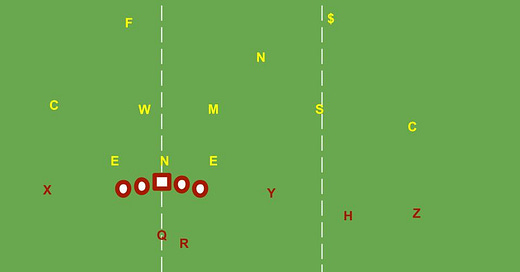Space Wars II: Matt Campbell's defense in depth
What if it's better to encourage the offense to run the ball?
Most games with boundaries of play have particular spaces everyone understands to be particularly important. Spaces which winning teams aim to control and dominate. In basketball, it’s often the paint area around the basket (although this is evolving). In soccer it’s midfield.
Football has classically been defined as a game in which contests are won or lost in the trenches at the line of scrimmage.
Urban Meyer with his hard-nosed culture and desire to marshall physical, smashmouth teams saw the spread offense as a great way to allow him to control games in the box. If he could force defenders to vacate the box in order to avoid getting gashed in space, he could do what every old school coach had always wanted to do and just repeatedly power the ball downhill in the interior gaps.
He initially got it going at Bowling Green back in 2002 with quarterback Josh Harris, a 6-foot-1, 245 pound bludgeon who ran for 20 rushing touchdowns that season in Meyer and Dan Mullen’s power-spread system.
After he left Bowling Green for Utah, the program hired a young grad assistant who’d just finished a college career as a defensive lineman for the vaunted Mount Union Purple Raiders. An Ohioan coach’s son named Matt Campbell.
Mount Union won the National Championship at the DIII level all three seasons he was there (along with all three years before he arrived) and Campbell would eventually head back there to serve as the offensive coordinator.
First he was going to learn a thing or two about the spread offense which Urban Meyer had introduced.
After a nice stretch with Mount Union, he back to Bowling Green and was next hired as head coach for Toledo. Campbell went 35-15 over five seasons in Toledo and finally left the state of Ohio to be the new head coach of the Iowa State Cyclones. There he found himself in the Big 12 conference facing some potent spread offenses two decades advanced from the original designs put forward by Meyer. He was also hardly inheriting either a roster loaded with talent nor an easy path to recruiting a better one.
Fortunately, Campbell and his defensive coordinator/fellow Rust Belt lifer Jon Heacock (brother to former Ohio State defensive coordinator Jim Heacock) had a background which clued them into the nature of their opponent.
In 2017 they’d develop a defense for countering these spread offenses which is becoming one of the fastest growing and evolving systems across college football.



